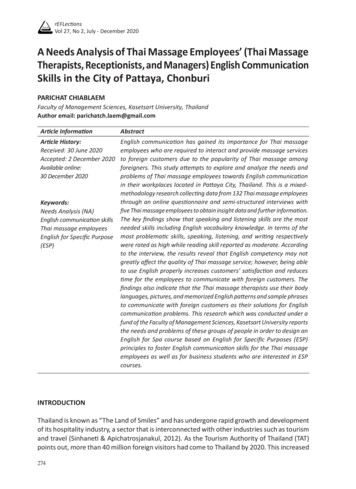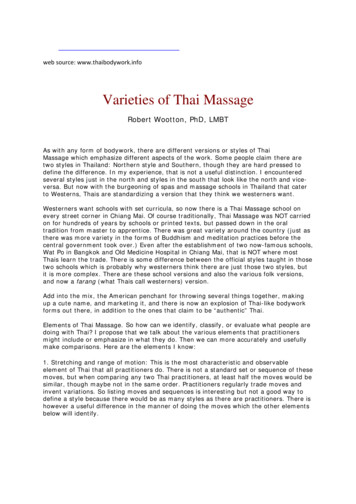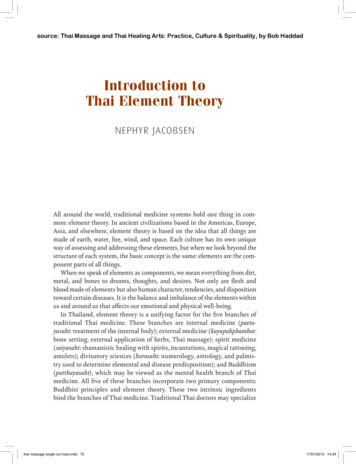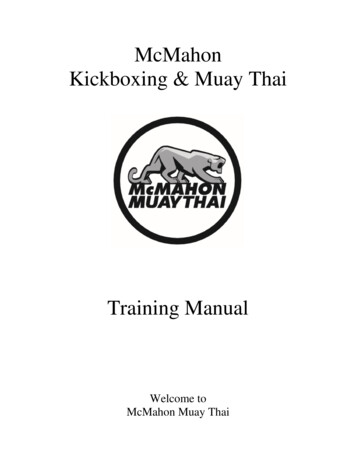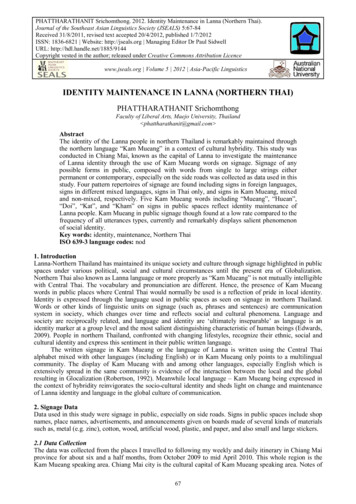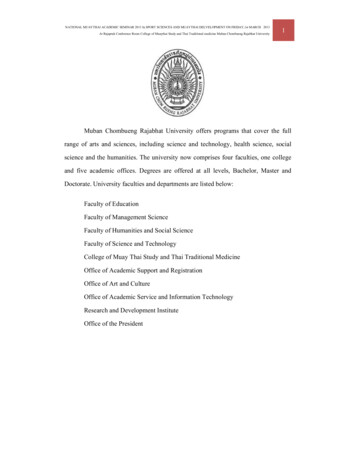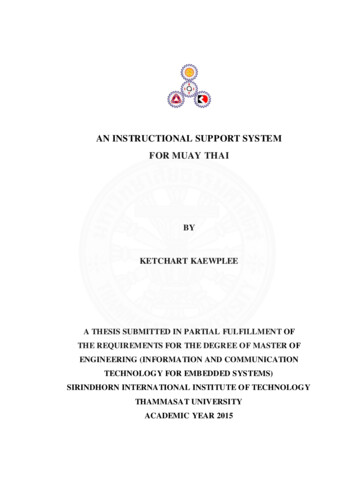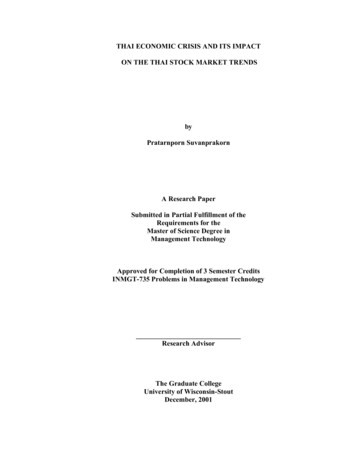
Transcription
1THAI ECONOMIC CRISIS AND ITS IMPACTON THE THAI STOCK MARKET TRENDSbyPratarnporn SuvanprakornA Research PaperSubmitted in Partial Fulfillment of theRequirements for theMaster of Science Degree inManagement TechnologyApproved for Completion of 3 Semester CreditsINMGT-735 Problems in Management TechnologyResearch AdvisorThe Graduate CollegeUniversity of Wisconsin-StoutDecember, 2001
2The Graduate CollegeUniversity of Wisconsin-StoutMenomonie, Wisconsin 54751ABSTRACTSuvanprakorn(Writer) (Last Name)Pratarnporn(First)-(Initial)Thai Economic Crisis and Its Impact on the Thai Stock Market Trends(Title)Management Technology Dr. Abel AdekolaDecember 2001 65(Graduate Major)(Research Adviser)(Month/Year)(Pages)Publication Manual of the American Psychological Association (APA), 4th Edition(Name of Style Manual Used in this Study)The Stock Exchange of Thailand (SET) was first established in 1961 as part ofThailand’s National Economic and Social Development Plan for the purpose ofenhancing the country’s economic growth. The operating performance of the SET grewsteadily until the first boom years of 1986-1989, which made the market capitalizationchanged much higher in its value. This remarkable rate of growth fascinated both localand foreign stock investors who invested their money heavily in the stock market sincethen.In late 1996, Thailand suffered a decrease in exports, which led to high deficit in thebalance of payment. Furthermore, the financial sector started to have problems inincreasing foreign debts.In 1997, the economic problems followed the devaluation of the Thai currency andthe increase in volume of non-performing loans, which made the performance outcomeof the listed member companies of the SET went down. These problems directly and
3strongly impacted the stock investors’ confidence, led to the decline in the Thai stockmarket trading volume and caused the SET Index hit the lowest point in its history inSeptember 1998.The stock market has an important role not only in helping the country to accelerateits economic growth, but also being an important indicator that can reflect the currenteconomic performance of that country. The country’s economic performance can beshown through the changing of the stock market index, which is crucial regarding to thedecisions making and confidence of the investors.The primary aim of this research is to analyze the Thai stock market trends asThailand moves into the twenty-first century after facing the peak of economic crisis.Most data provided are the comparison of the economic data from the years 1996-2000which can reflect the success level of the Thai governments’ measures in an effort toresolve the economic problems and encourage economic recovery in order to bring backpublic confidence.
iiiTABLE OF CONTENTSList of Tables. . . . . . . . . . . . . . . . . . . . . . . . . . . . . . . . . . . . . . . . . . . . . . . . . . . . . . . . .viChapter 1: IntroductionBackground of the Problem . . . . . . . . . . . . . . . . . . . . . . . . . . . . . . . . . . . . . . . . .1Statement of the Problem . . . . . . . . . . . . . . . . . . . . . . . . . . . . . . . . . . . . . . . . . . .3Research Objectives . . . . . . . . . . . . . . . . . . . . . . . . . . . . . . . . . . . . . . . . . . . . . . .3Significance of the Study . . . . . . . . . . . . . . . . . . . . . . . . . . . . . . . . . . . . . . . . . . .3Limitations and Scope . . . . . . . . . . . . . . . . . . . . . . . . . . . . . . . . . . . . . . . . . . . . .3Chapter 2: Literature ReviewThe Perspective of the Stock Exchange of Thailand (SET)-History, Role and Growth Performance . . . . . . . . . . . . . . . . . . . . . . . . . . .5-Securities Trading System . . . . . . . . . . . . . . . . . . . . . . . . . . . . . . . . . . . . . .7-Back-Office Systems . . . . . . . . . . . . . . . . . . . . . . . . . . . . . . . . . . . . . . . . . .9-Information Disclosure . . . . . . . . . . . . . . . . . . . . . . . . . . . . . . . . . . . . . . . .10-Information Dissemination . . . . . . . . . . . . . . . . . . . . . . . . . . . . . . . . . . . . .11-Member Supervision . . . . . . . . . . . . . . . . . . . . . . . . . . . . . . . . . . . . . . . . . .12-Market Surveillance . . . . . . . . . . . . . . . . . . . . . . . . . . . . . . . . . . . . . . . . . . . 14-Investment Policy for Foreign Investors . . . . . . . . . . . . . . . . . . . . . . . . . . .14The Economic Turmoil in South East Asia: Root Causes-Drastic Export Slowdown . . . . . . . . . . . . . . . . . . . . . . . . . . . . . . . . . . . . . .17-Real Estate: The Root Cause of the Financial Crisis . . . . . . . . . . . . . . . . .18-Foreign Debts . . . . . . . . . . . . . . . . . . . . . . . . . . . . . . . . . . . . . . . . . . . . . . . .18-The Foreign Exchange System . . . . . . . . . . . . . . . . . . . . . . . . . . . . . . . . . .19
ivThai Economic Crisis Review . . . . . . . . . . . . . . . . . . . . . . . . . . . . . . . . . . . . . . . . 20Thai Stock Market Condition During the Peak of the Crisis (1997-1998) . . . . . .24Reaction of the Stock Exchange of Thailand to the Economic Crisis . . . . . . . . .26-The Economic Crisis Response Plan . . . . . . . . . . . . . . . . . . . . . . . . . . . . . .27-The On-Going Development Plan . . . . . . . . . . . . . . . . . . . . . . . . . . . . . . . .29Chapter 3: Research MethodologyIntroduction . . . . . . . . . . . . . . . . . . . . . . . . . . . . . . . . . . . . . . . . . . . . . . . . . . . . . . 31Statement of the Problem . . . . . . . . . . . . . . . . . . . . . . . . . . . . . . . . . . . . . . . . . . .31Research Objectives . . . . . . . . . . . . . . . . . . . . . . . . . . . . . . . . . . . . . . . . . . . . . . .31Research Design . . . . . . . . . . . . . . . . . . . . . . . . . . . . . . . . . . . . . . . . . . . . . . . . . . 32Instrumentation . . . . . . . . . . . . . . . . . . . . . . . . . . . . . . . . . . . . . . . . . . . . . . . . . . .33Limitations and Scope . . . . . . . . . . . . . . . . . . . . . . . . . . . . . . . . . . . . . . . . . . . . . . 33Chapter 4: Presentation of ResultsIntroduction . . . . . . . . . . . . . . . . . . . . . . . . . . . . . . . . . . . . . . . . . . . . . . . . . . . . . .34The results of Thai Government’s Measures for Economic Stabilization . . . . . .36-Macroeconomic Framework1.1 International Reserves and Exchange Rates . . . . . . . . . . . . . . . . . . .371.2 Inflation and Interest Rates . . . . . . . . . . . . . . . . . . . . . . . . . . . . . . . .381.3 International Trade . . . . . . . . . . . . . . . . . . . . . . . . . . . . . . . . . . . . . .411.4 Private Investment . . . . . . . . . . . . . . . . . . . . . . . . . . . . . . . . . . . . . .431.5 Unemployment Rate . . . . . . . . . . . . . . . . . . . . . . . . . . . . . . . . . . . . .441.6 Gross Domestic Product (GDP) . . . . . . . . . . . . . . . . . . . . . . . . . . . .46
v-Financial Sector Restructuring2.1 Strengthening and Re-Capitalizing Viable Financial Institutions . . . 492.2 Addressing of the Non-Performing Loan (NPL) Problem . . . . . . . . 50The Thai Stock Market Trends in the Beginning years of the 21st Century . . . . .53Foreign Investors and the Thai Stock Market . . . . . . . . . . . . . . . . . . . . . . . . . . . .56Chapter 5: Conclusions and RecommendationsConclusions . . . . . . . . . . . . . . . . . . . . . . . . . . . . . . . . . . . . . . . . . . . . . . . . . . . . . .57Recommendations . . . . . . . . . . . . . . . . . . . . . . . . . . . . . . . . . . . . . . . . . . . . . . . . .60Bibliography . . . . . . . . . . . . . . . . . . . . . . . . . . . . . . . . . . . . . . . . . . . . . . . . . . . . . . . . . 62
viLIST OF TABLESTablePageChapter 22-A: Types of Trading Boards and the Trading Systems . . . . . . . . . . . . . . . . . . .92-B: Securities Clearing and Settlement Schedules . . . . . . . . . . . . . . . . . . . . . . .102-C: Classification of Commission Rates . . . . . . . . . . . . . . . . . . . . . . . . . . . . . .122-D: Stock Price Spreads . . . . . . . . . . . . . . . . . . . . . . . . . . . . . . . . . . . . . . . . . . .132-E: Foreign Investment Volume in the Thai Stock Market (1982-1996) . . . . . . 15Chapter 44-A: Comparison of Thailand’s Key Economic Indicators (1996-2000) . . . . . . . 354-B: Thai Currency Average Exchange Rates . . . . . . . . . . . . . . . . . . . . . . . . . . .384-C: Thai Commercial Bank Deposit Rate as of December 2000 . . . . . . . . . . . .404-D: Thailand’s International Trade (1998-2000) . . . . . . . . . . . . . . . . . . . . . . . . 434-E: Labor Force and Unemployment Rates . . . . . . . . . . . . . . . . . . . . . . . . . . . . 454-F: GDP Classified by Industrial Origin (Billion Baht) . . . . . . . . . . . . . . . . . . .474-G: The Thai Stock Market Performance (1996-2000) . . . . . . . . . . . . . . . . . . .54
1CHAPTER 1IntroductionBackground of the ProblemThe stock market index is generally thought to be an economic leading indicator. Itis one of the crucial factors economists consider using to forecast the future performanceof the country’s economic activities. An important reason why stock market index isconsidered to be a leading rather than lagging indicator is that investors are forwardlooking, they buy or sell stocks today based on their expectations of how companies willperform and how the country’s economic outcome will be in the future. Stock marketalso can help accelerate economic growth through creation of liquidity by playing animportant role in encouraging the savings mobilization and efficiently allocating thecapital for investment activities in a number of ways as follows:First, stock market can be used as a vehicle for raising equity capital for firms. Stockmarket may also take larger role in developing countries where private sector imply alarge demand for equity finance.Second, stock market in general, can enable investors to diversify their wealth acrossa variety of financial instruments and reduce the cost of capital by reducing the investors’risk premium. The result should increase the investment levels and enhance economicdevelopment.Third, stock market can perform a screening and monitoring role by relying on theinformation and judgment of numerous participants. Stock prices quickly reflect thechanges in underlying values and indicate profitable investment opportunities.
2Lastly, the public corporations, which are members of the stock market, cannot makeany decisions without considering the shareholders and social responsibilities. Theresults of improving in corporate administration should be contributed to economicdevelopment (Stock Exchange of Thailand [SET], 1998).In the middle of 1996, economic recession in Thailand began to take place but it wascovered by the government’s measures through financing and subsidizing the declinedbusinesses, most of which were speculative sectors such as stock exchange market andreal estate development. The really first hit of the economic crisis came in the middle of1997 with the devaluation of the Thai currency (Baht) and followed by rapidly falling ofthe Thai stock market index. A series of the country’s key economic indicators showedtheir severity. The Stock Exchange of Thailand (SET) Index dropped 55 percent from1997 to 1999, which was the worst record in history of the Thai stock trading.Thai government continuously launched several economic measures to stimulate theweak economy such as the announcing of the August 10th 1999 Stimulus Package as wellas the Stock Exchange of Thailand that also implemented plans in 1998 to deal with thecrisis in an effort to rescue the stock market. The key economic data of Thailand thathave been publicly released since 1999 could reflect the success level of the Thaigovernment’s economic stimulation measures in resolving the weak economy aftergetting through the peak of economic crisis (Ministry of Finance, Thailand, 2000).In this research, the researcher will discuss and analyze a series of Thai keyeconomic data, which are important factors that could impact the stock investors’decision making and the stock market performance in order to forecast the future trendsof the Thai stock market.
3Statement of the ProblemThe problem of this study is to determine the Thai stock market trends in thebeginning years of the twenty-first century after facing the peak of the economic crisis.Research ObjectivesThe objectives of this research study are to:1. Understand general Thai stock market perspective.2. Understand the situation of Thai economic crisis.3. Determine the impact of Thai economic crisis on the Thai stock market.4. Determine the future trends of the Thai stock market.Significance of the StudyIt is essential to study Thailand’s key economic indicators in order to measure theprogress of economic recovery in Thailand after facing the peak of its economic crisisbecause such information is important to stock investors’ decision making. The results ofeconomic data analyses will be served as a resource for investors who are interested ininvesting their money in the Thai stock market.Limitations and ScopeThere are two broad types of stock market analysis methods, one is economicfundamental analysis method and the other is technical analysis method. The researcherfocuses on the economic fundamental analysis method, which is based on analysis of keyeconomic data of Thailand that have strong impact on stock investor’s decision makingand also on the future trends of the Thai stock market. Technical analysis method, whichis based on the analysis of historical statistic of stock trading volume and graphs, will notbe discussed in this research. This research was not conducted to analyze specific stock
4of each listed member company of the Stock Exchange of Thailand but to analyze overallperformance of the Thai stock market in order to forecast its future trends after beingimpacted by the economic crisis.
5CHAPTER 2Review of LiteratureThe Perspective of the Stock Exchange of Thailand (SET)History, Roles and Growth PerformanceOrganizational History of the Stock Exchange of Thailand (SET)Thailand's National Economic and Social Development (NESD) Plans have, since1961, defined the country's direction and growth objectives. Consequently, the SecondPlan (1967-71) incorporated planning for a new capital securities market. The ThirdNESD Plan (1972-76) gave rise to the Stock Exchange of Thailand (SET) Act of May1974, bringing into being The Securities Exchange of Thailand, as it was first named.Securities trading commenced on April 30,1975. On January 1,1991, the bourse's officialname was changed to The Stock Exchange of Thailand (SET). In May 1992, animproved SET Act of 1984 (No. 2) was itself replaced by the Securities and ExchangeAct (SEA) 1992, which also established the Securities and Exchange Commission (SEC)as the sole supervisor of securities business (Stock Exchange of Thailand [SET], 2000).The SEA is a comprehensive legislative framework regulating all vital elements of amodern capital market, such as disclosure, investor protection, fund management,takeover procedures and the establishing of securities firms (Stewart, 1995).Roles of the Stock Exchange of ThailandThe SEA defines three prime objectives for the SET, which are to:1. Provide the services of being a center for trading listed securities and thesystem and methods for securities trading.
62. Undertake any related business, such as acting as a clearinghouse, securitiesdepository center, securities registrar and providing securities data.3. Undertake any other business given the approval of the SEC.The SET is a full self-regulatory organization, which with the SEC ensures allindividuals and institutions abide by the established laws, regulations and standards ofThailand's capital market. Moreover, the SET continuously strives for expansion andimprovement of products and services for investors worldwide (SET, 2000).Growth PerformanceAt the end of its first year of operation in 1975, there were just 21 SET ’s listedmember companies and total trading turnover topped 547.32 million Baht. By the end of1993, total annual turnover had reached 2,201.15 billion Baht on a daily average of8,984.28 million Baht. On January 4,1994, the market opened at an historic high of1753.73 Index points and the following day recorded its highest-ever trading turnover of40.01 billion Baht. Those original 21 listed member companies have since grown to 392stocks and have been joined by 20 unit trusts or mutual funds as well as preferred shares,debentures and warrants of various types. Market capitalization has changed since theFirst Boom years of 1986-89 to a present value equal to 2,193.07 billion Baht (SET,2000).This remarkable rate of growth had been in parallel with the SET 's own historicprogress and initiatives. The Automated Trading System for the SET (ASSET) wasimplemented in May 1991. While in June 1992, the SET 's Share Depository Centeradopted a non-script system which now includes debentures and warrants. In July 1992,trading hours were increased, as they were again in November 1994.
7As a result of such rapid progress, foreign trading on the SET doubled between 1991and 1992, and continued its growth on the upward trend to account for over 940 billionBaht in 1999, approximately 29.44% of total trading turnover (SET, 2000).Securities Trading SystemTrading MechanismThe SET has operated full-computerized trading since May 1991. There are twoprinciple variations of trading system available to broker members, Automated OrderMatching (AOM) and Screen-based trading or Put Through (PT) system. Automated Order Matching (AOM) SystemMember firms key in their orders from their offices and these data goonline to the SET 's mainframe computer which the ASSET system arranges the ordersaccording to price-then-time priority. Executed transactions are immediately confirmedback to the members' terminals. Screen-based trading or Put Through (PT) SystemBrokers can announce bid or offer prices quoted according to the pricespread rules of the SET via the ASSET 's facility. Any interested brokers can deal andnegotiate directly between each other, which the price can be changed and may notfollow the price spread rules. The result of the deal will be then sent to the ASSETsystem for the SET 's formal approval.Whichever type of trading system is applicable depends on the board the shares aretraded on. AOM is provided for trading on the main board and the odd lot board, while
8PT is applied for trading on the special board and the big lot board. On the foreign board,both the AOM and PT systems can be utilized (SET, 1999).The Five Boards and Trading UnitsSecurities trading at the SET can be conducted on five separate trading boards.Generally, each trading unit, a so-called "Board Lot", contains 100 units of each security.However, for each security priced at 500 Baht or more for six consecutive months, oneboard lot is equivalent to 50 shares (SET, 1999).The followings are five types of trading boards:1. The Main Board is for the trading of common stocks, preferred stocks,warrants and unit trusts in full board lots, not exceeding one million units of eachsecurity.2. The Foreign Board is for the trading of stocks registered under aforeigner name.3. The Big Lot Board is for the trading of all securities with the minimumvalue of three million Baht or the minimum volume of one million shares.4. The Odd Lot Board is for the trading of common stocks, preferredstocks, warrants and unit trusts in less than a one board lot.5. The Special Board is for the trading of government and state enterprisesecurities such as bonds, debentures and convertible debentures.Trading systems of the SET, both AOM and PT, are utilized according to the type ofboard that the stocks are traded on, as shown in the table 2-A.
9Table 2-A: Types of Trading Boards and the Trading SystemsTYPES OF TRADING BOARDSTRADING SYSTEMSMain BoardAOMSpecial BoardPTOdd Lot BoardAOMBig Lot BoardPTForeign BoardAOM or PTBack-Office SystemsThe Thailand Securities Depository Co., Ltd. (TSD), a subsidiary of the StockExchange of Thailand (SET), was established on November 16, 1994, and officiallybegan operations on January 1, 1995. TSD's main function is to develop and promoteback-office systems for the after-trade services provided for all types of equities and debtinstruments in Thailand in order to attain the highest efficiency and meet internationalstandards. TSD is the only clearing house and control securities depositary, and theindustry's main stocks register. It serves the SET 's member companies, sub-brokers,custodian banks, members of the Bond Dealers' Club, and members of the BangkokStock Dealing Center (Thailand Securities Depository Company Limited [TSD], 1999).Securities Clearing & SettlementThe traded securities as reported on the TSD 's and its members' computer terminalsneeded to be cleared and settled according to the following procedures as shown in table2-B in the following page:
10Table 2-B: Securities Clearing and Settlement SchedulesEFFECTIVE ON12 JUNE 1995THAI INVESTORFOREIGNINVESTOR/MUTUAL FUND CO.SUB-BROKERWithin T 3Within T 4Within T 3Within T 4Within T 4Within T 4Within T 3Within T 3Within T 3Within T 2BuyDate for customersto make paymentfor the purchaseDate for member todeliver thesecurities tocustomerSellDate for member toWithin T 3make payment forthe saleDate for customerBefore 12.00 noonto deliver theof T 1securities to thememberNote. T Trading day.Moreover, the TSD sends a report of net trading and net cash balance to its membersvia computer network at, approximately, 6.30 p.m. of each trading day. In case theclearinghouse's computer system fails, a written report of trades and net cash balanceswill be sent to the members on the following day (TSD, 1999).Information DisclosureInformation Disclosure RequirementsTo ensure active, fair and orderly securities trading in the Exchange, the SETrequires its listed companies to disclose information necessary for decision-making to the
11general public. Such information must be filed to the SET by fax and simultaneously online through the Electronic Listed Companies Information Disclosure System, or ELCID.The ELCID system facilitates the listed companies to transmit their materialinformation accurately, widely, and timely via a faster process. From July 1, 1998onwards, all listed companies must simultaneously disclose both in Thai and English viathe ELCID system to be in line with international standard. The transferred informationwill be collected as a database for the SET 's information systems later on (Office of theSecurities and Exchange Commission [SEC], 1997).Information DisseminationINTERNETThe SET 's home page at the address "http://www.set.or.th" includes the SET index,trading information (prices and volume of listed stocks) and daily news released by listedcompanies. Besides real time quotation, general information regarding the SET as wellas reports on monthly economic performance prepared by the Bank on Thailand (BOT)are available on the internet.Mass Media and PublicationsBesides the information dissemination via electronic system such as SETINFO andthe INTERNET, the SET also provides stock trading information, information regardingthe SET 's brokerage members/listed companies and educational programs on stockmarket through channel 9 TV, cable television network, and radio broadcasts.The SET offers publications, which investors can regularly subscribe such as theAnnual Report, Monthly Review, Fact Book, etc. (SET, 1999).
12Member SupervisionThe SET regulates and supervises member companies in the following areas: Trading activities & operations Members' financial statusTrading Activities & OperationsTo supervise the member firms in terms of trading and operation, the SET hasregulated the rates of commission and the price regulation on trading as follows:1. Brokerage Commission - The commission fees paid to a broker for eitherbuying or selling securities are designated as shown in table 2-C:Table 2-C: Classification of Commission RatesTYPES OF SECURITIESCOMMISSION RATESOrdinary Shares, Preferred Shares andWarrants0.5% of value traded(Minimum 50 Baht or US 2.00)Unit Trusts0.3% of value traded(Minimum 30 Baht or US 1.20)Government Bonds,Debentures andConvertible Debentures0.1% of value traded(Minimum 50 Baht or US 2.00)2. Price Regulations Opening Price: Prior to the regular trading session, pre-openingorders can be sent to the SET but they will not be matched. They are simply placed inbid or offer queues according to a price and time priority and price is counted as the firstpriority. The opening price is determined by the price that generates the most trading
13volume. If there is more than one price, the one closer to the previous closing price willbe chosen. If there is still more than one price, the higher one will be chosen. Floor & Ceiling Limits: The stock prices can fluctuate within therange of or - 10 percent of the main board's last trading price on the previous tradingday which mean that the price of each stock can not drop below 10 percent floor orincrease beyond 10 percent ceiling. Price Spreads: Price movements, as prescribed by the SET forsecurities trading, vary according to each market price level as details shown in table 2-Don the following page.Table 2-D: Stock Price SpreadsMARKET PRICE LEVEL (BAHT)SPREAD (BAHT)Less than 100.10From 10 to 500.25From 50 to 1000.50From 100 to 2001.00From 200 to 6002.00From 600 to 1,0004.00From 1,000 upwards6.00Members' Financial StatusMember companies are required to submit both their audited semi-annual and annualfinancial reports, quarterly listing of top 20 shareholders, changes in executive
14management and other pertinent reports. The SET will review these reports and evaluatethe financial condition of the members (SET, 1999).Market SurveillanceSurveillance SystemSince 1983, the SET has set up an effective surveillance system to detect anyirregular patterns of stock price and volume movements. The system is semicomputerized and closely observed by trained personnel. The surveillance process can bedivided into two parts: Stock Watch and Stock Alert part and Investigation Process part.Both stock watch and stock alert activities work simultaneously and are designed tomonitor any peculiar trading movements of listed stocks. The system will alert theassigned officers through audio signals and visible colored labels for any irregularity.Preliminary investigation into the cause of the alert will follow. Appropriate measure inthe form of warning signs "H" (trading Halt), "SP" (suspension), etc., will be imposed ifnecessary. The second part refers to the "Investigation process". If serious wrongdoingoccurs, the SET will set up a subcommittee to conduct an investigation, and forward theresults obtained to the SEC (SET, 1999).Investment Policy for Foreign InvestorsInvestment volume from foreign investors was increasing gradually from 1982 to1996 as shown in table 2-E.
15Table 2-E: Foreign Investment Volume in the Thai Stock Market (1982-1996)YEARFOREIGN INVESTMENT(US Million)PERCENTAGE OF 6Note: US 1 is approximately 25.28 Baht (1982 - 1996)Foreign investors may invest directly on the SET or through foreign funds, which aredefined as on- shore and off -shore funds. Under the SEA ’s regulations, on-shoreforeign funds are registered in Thailand and their investment plans approved by the officeof the SEC. Fund managers of on-shore funds are Thai companies, and therefore thesefunds are not subject to the foreign share-ownership restrictions for any particular stock.Off -shore funds are foreign funds registered abroad and managed by institutionalinvestors. They are subject to foreign share-ownership restrictions (SET, 1999).Five Steps for Foreigner to Invest in the Stock Exchange of ThailandStep One: Appointing custodian, correspondent bank and brokerTo invest in the SET, foreign investors must appoint custodians, correspondent banks
16and brokerage firms on their behalf. Normally, local commercial banks provide bothcustodian services and act as correspondent banks for such clients. Foreign investors areadvised to use only one bank for both services.Step Two: Bringing in moneyThe inward remittance of foreign exchange for portfolio investments must beconducted through a correspondent bank. Clients are not required to file the remittancereport directly with the Bank of Thailand (BOT) because the correspondent bank will actas an intermediary in fund transfers and assist its clients by reporting to the BOT on theirbehalf. Thai currency is the only accepted medium in trading securities at the SET.Step Three: Placing ordersBuy or sell orders must be placed through a broker. The SET is fully computerizedfor execution and confirmation of orders.Step Four: Clearing and settlementAll settlement is done on a T 3 working days basis, where T is the trading day by netsettlement for each customer.Step Five: Repatriation of fundsThe repatriation of investment funds, dividends and profits, as well as loanrepayments and interest payments - net of all taxes - can be made through acorrespondent bank who will facilitate the outward remittance. A correspondent bankwill help ease the process of approval for the repatriation of any proceeds by filing theremittance report to the BOT on behalf of its clients. In this way, the clients are notrequired to report directly to the BOT.
17The Economic Turmoil in South East Asia: Root CausesDrastic Export SlowdownPrior to 1996, exports of the four ASEAN (The Association of Southeast AsianNatio
the Thai stock market index. A series of the country's key economic indicators showed their severity. The Stock Exchange of Thailand (SET) Index dropped 55 percent from 1997 to 1999, which was the worst record in history of the Thai stock trading. Thai government continuously launched several economic measures to stimulate the


